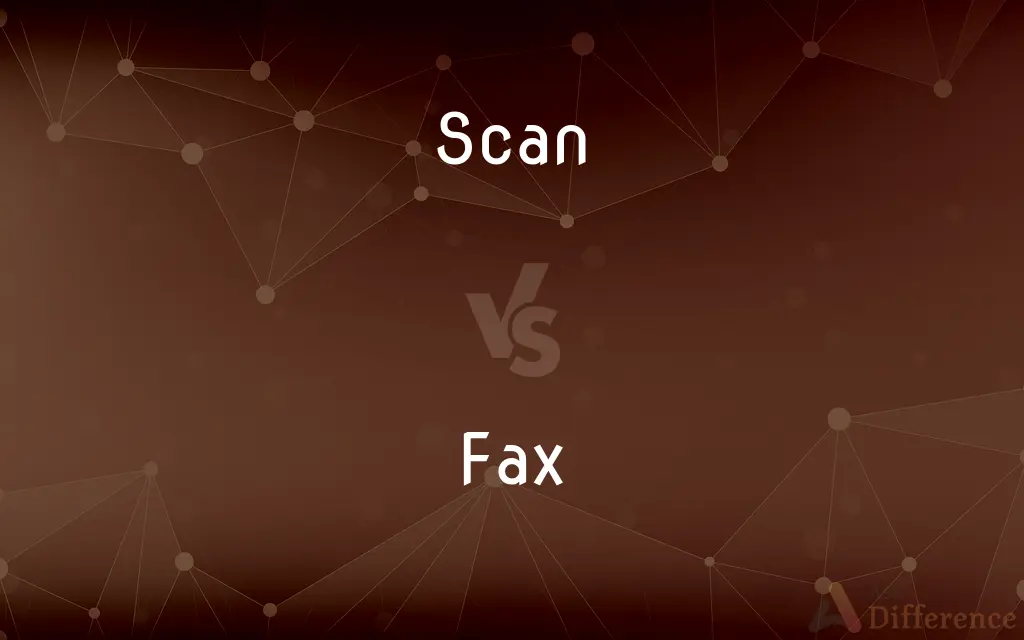Scan vs. Fax — What's the Difference?
By Fiza Rafique & Maham Liaqat — Updated on March 7, 2024
Scan converts documents into digital format for editing or storage, while fax transmits scanned images via telephone lines for instant receipt.

Difference Between Scan and Fax
Table of Contents
ADVERTISEMENT
Key Differences
Scanning involves creating a digital copy of a document or image, which can then be stored, edited, or shared electronically. This process relies on a scanner or multifunction printer. Whereas faxing, a technology that predates scanning, involves sending a copy of a document through telephone lines to a recipient's fax machine, resulting in a printed copy on the other end.
Scanners typically produce higher resolution images, allowing for better quality reproductions of the original document. This is particularly useful for documents requiring detailed visuals. On the other hand, fax machines transmit images at a lower resolution, which can result in loss of detail, making them less ideal for images but sufficient for text documents.
Scanning offers flexibility in terms of file types and distribution methods. Scanned documents can be saved in various formats like PDF, JPEG, or TIFF, and easily shared via email or cloud services. In contrast, faxing is limited to sending documents directly to another fax machine, without the option for file type selection.
Modern scanning technology often incorporates document management systems, facilitating easy organization, search, and retrieval of digital documents. Conversely, faxed documents, unless scanned upon receipt, do not integrate as seamlessly into digital document management systems, often requiring manual organization.
Scanning is considered more secure for sensitive information, as it avoids the potential for interception inherent in fax transmission through public telephone networks. Faxing, while still used for its legal authenticity and direct transmission capability, carries higher risks of security breaches.
ADVERTISEMENT
Comparison Chart
Medium
Digital files (PDF, JPEG, TIFF)
Paper document transmitted over telephone lines
Quality
Higher resolution, better for detailed visuals
Lower resolution, sufficient for text, less for images
Distribution
Via email, cloud services, or stored electronically
Direct to another fax machine
Document Management
Easily integrated into document management systems
Requires manual organization if not digitally converted
Security
Higher due to digital transmission and storage options
Lower due to potential for interception over telephone lines
Compare with Definitions
Scan
Digitizing documents or images for electronic storage.
I'll scan these receipts for our digital records.
Fax
Sending legal or official documents quickly.
We need to fax our response to the proposal today.
Scan
Converting hard copies into editable digital formats.
We scanned the contract to make some last-minute changes.
Fax
A method for direct document transmission without the internet.
Without internet, faxing is our best option for sending this.
Scan
Using OCR technology to convert scanned images into text.
After scanning the document, the OCR software converted it into editable text.
Fax
Receiving hard copies of documents from remote locations.
The fax from our supplier just arrived.
Scan
Creating high-resolution digital copies of photographs.
I scanned old family photos to preserve them online.
Fax
Transmitting scanned copies of documents over telephone lines.
Fax the signed documents to the lawyer immediately.
Scan
Capturing a document's image to email or archive.
Scan the invoice, so we can send it to accounting.
Fax
Using a dedicated machine to send documents.
Is the fax machine working? I have documents to send.
Scan
To look at carefully or thoroughly, especially in search of something; examine
The sailor scanned the horizon for signs of land.
Fax
Fax (short for facsimile), sometimes called telecopying or telefax (the latter short for telefacsimile), is the telephonic transmission of scanned printed material (both text and images), normally to a telephone number connected to a printer or other output device. The original document is scanned with a fax machine (or a telecopier), which processes the contents (text or images) as a single fixed graphic image, converting it into a bitmap, and then transmitting it through the telephone system in the form of audio-frequency tones.
Scan
To look over quickly or read hastily
I scanned the newspaper while eating breakfast.
Fax
A fax machine.
Scan
(Computers)To search (stored data) automatically for specific data.
Fax
A document transmitted or received by a fax machine. In both senses also called facsimile.
Scan
To direct a finely focused beam of light or electrons in a systematic pattern over (a surface) in order to reproduce or sense and subsequently transmit an image.
Fax
To transmit (a document) by a fax machine.
Scan
To direct a radar beam in a systematic pattern across (a sector of sky) in search of a target.
Fax
The hair of the head.
Scan
To encode (text, for example) in digital format by means of an optical scanner.
Fax
Senseid|en|machine}} {{ellipsis of fax machine
Scan
(Medicine)To direct x-rays or other energy at (a body or body part) in order to produce an image, as with a CT scanner.
Fax
A document sent, or received and printed by a fax machine
Scan
To pass (luggage, for example) through a detector at a security checkpoint in order to detect weapons or banned materials.
Fax
To send a document via a fax machine.
Scan
To analyze (verse) into metrical patterns.
Fax
Alt form of facts.
Scan
To analyze verse into metrical patterns.
Fax
Duplicator that transmits the copy by wire or radio
Scan
To conform to a metrical pattern
Does this line scan?.
Fax
Send something via a facsimile machine;
Can you fax me the report right away?
Scan
The act or an instance of scanning
My scan of the files.
Scan
The action or process of scanning a body or body part.
Scan
An image produced by scanning.
Scan
(transitive) To examine sequentially, carefully, or critically; to scrutinize; to behold closely.
She scanned the passage carefully but could not find what she was looking for.
Scan
(transitive) To look about for; to look over quickly.
He scanned the horizon.
Scan
To inspect, analyse or go over, often to find something.
To scan the hard drive for errors
Scan
To perform lexical analysis; to tokenize.
Scan
To create an image of something with the use of a scanner.
To scan a photograph
To scan internal organs by means of computed tomography
Pencil drawings don't scan very well.
Scan
To read with an electronic device.
To scan a barcode
To scan a QR code
Scan
To mount by steps; to go through with step by step.
Scan
To read or mark so as to show a specific metre.
To scan verse
Scan
(intransitive) To conform to a metrical structure.
Scan
Close investigation.
Scan
(computing) An instance of scanning.
The operators vacated the room during the scan.
Scan
(computing) The result or output of a scanning process.
The doctors looked at the scans and made a diagnosis.
Scan
To mount by steps; to go through with step by step.
Nor stayed till she the highest stage had scand.
Scan
Specifically (Pros.), to go through with, as a verse, marking and distinguishing the feet of which it is composed; to show, in reading, the metrical structure of; to recite metrically.
Scan
To go over and examine point by point; to examine with care; to look closely at or into; to scrutinize.
The actions of men in high stations are all conspicuous, and liable to be scanned and sifted.
Scan
To examine quickly, from point to point, in search of something specific; as, to scan an article for mention of a particular person.
Scan
To form an image or an electronic representation of, by passing a beam of light or electrons over, and detecting and recording the reflected or transmitted signal.
Scan
The act of scanning; systematic examination of a prescribed region;
He made a thorough scan of the beach with his binoculars
Scan
An image produced by scanning;
He analyzed the brain scan
You could see the tumor in the CAT scan
Scan
Examine minutely or intensely;
The surgeon scanned the X-ray
Scan
Examine hastily;
She scanned the newspaper headlines while waiting for the taxi
Scan
Make a wide, sweeping search of;
The beams scanned the night sky
Scan
Conform to a metrical pattern
Scan
Move a light beam over; in electronics, to reproduce an image
Scan
Read metrically;
Scan verses
Scan
Obtain data from magnetic tapes;
This dictionary can be read by the computer
Common Curiosities
Can scanned documents be edited?
Yes, scanned documents can be edited, especially if OCR technology is used to convert images into text.
Do I need a physical machine to scan or fax?
Yes, scanning typically requires a scanner or multifunction printer, while faxing requires a fax machine or multifunction printer with fax capabilities.
Is faxing secure?
Faxing is less secure than digital methods due to potential interception over telephone lines.
Can faxed documents be converted into digital format?
Yes, faxed documents can be scanned and converted into digital format upon receipt.
Are there any legal advantages to faxing documents?
Faxes are often considered legally binding and have a sense of immediacy and receipt confirmation that digital documents may lack.
What is scanning?
Scanning is the process of converting a physical document or image into a digital format.
Is one method faster than the other?
Scanning is typically faster for creating digital copies, while fax speed depends on the transmission over telephone lines.
Do both methods require internet?
Scanning does not require internet unless you are sending the document online, whereas traditional faxing does not use the internet but telephone lines.
What is faxing?
Faxing is transmitting scanned images of documents via telephone lines to another fax machine.
Which produces better quality, scanning or faxing?
Scanning generally produces better quality images due to higher resolution capabilities.
Can I send a fax without a phone line?
Yes, online fax services allow sending faxes without a traditional phone line.
Can I fax a document to an email?
Yes, through online fax services, it's possible to fax directly to an email address.
Which method is more environmentally friendly?
Scanning is more environmentally friendly as it reduces paper usage and relies on digital storage.
How do I share scanned documents?
Scanned documents can be shared via email, cloud services, or other electronic means.
What file formats can scanned documents be saved in?
Scanned documents can be saved in various formats, including PDF, JPEG, and TIFF.
Share Your Discovery

Previous Comparison
Whallah vs. Wallah
Next Comparison
Determination vs. PerseveranceAuthor Spotlight
Written by
Fiza RafiqueFiza Rafique is a skilled content writer at AskDifference.com, where she meticulously refines and enhances written pieces. Drawing from her vast editorial expertise, Fiza ensures clarity, accuracy, and precision in every article. Passionate about language, she continually seeks to elevate the quality of content for readers worldwide.
Co-written by
Maham Liaqat











































